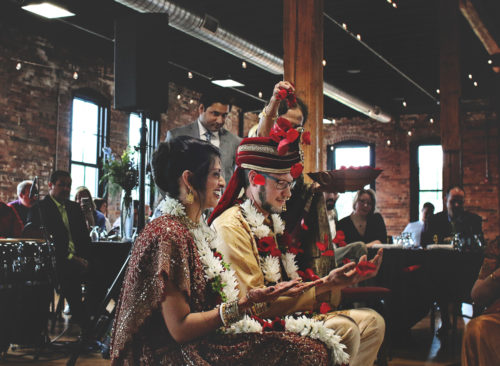by Bakul Banerjee
That February 2017 morning, crisp sunshine bathed the white snow blanketing the backyard. Remnants of snow still lingering on the old fence-posts gave the illusion of a decorative sequence of mortises that had no practical use. Few bird-nests were still clinging to the bare branches of mature mulberry trees.
I remembered my first visit to the nearby Arbor Day fair with my daughters where I bought them a copy of the book, ‘50 Simple Things Kids Can Do to Save the Earth’. It was probably 1991. At the fair, we also learned how to attract birds and bees to backyards. Returning home, I recognized several mulberry saplings growing in the flower bed at the edge of the yard. Over the years, two of them matured into tall trees giving shelters and food to numerous birds, chipmunks, and other small creatures.
I looked at the crumpled piece of sticky aluminum foil in my hand. I was trying to talk myself out of throwing it in the kitchen trash. I did not want to go to the freezing garage to ditch it in the recycle bin, but I had to. My daughter wouldn’t approve of not recycling the foil. It was uncanny how a simple paperback book can influence a child’s philosophy of life for good. I recalled the arguments she had with her sister about the environment. Like me, her sister often tried to take shortcuts in the quest for conserving the world.
My first-born found her mate, a young man who shared similar interests. On a dark winter night, he took her out to show her the ring-shaped Messier 57 or the Ring Nebula through his telescope and proposed to her. The picture of the nebula arrived in my Inbox immediately without much explanation. The picture of the diamond ring came a few days later with the disclaimer that it was a conflict-free diamond. I smiled as I remembered her years of anguish over blood diamonds mined in Africa. I have been waiting for this good news for years but kept my mouth shut as she went through her education, job searches, and career development. The photo of my daughter driving a large Caterpillar Dozer with operating weight of eighty-seven thousand pounds is one of my prized possessions. However, I was certainly happier with the Ring Nebula.
“Ma, can you get us married?” My daughter’s request came soon after. I was surprised. They wanted to have a Vedic marriage ceremony. I was delighted but apprehensive at the same time. It would be my fifteenth wedding to co-officiate. With the blessings of my spiritual elders, I also led numerous worships and sacramental rituals over the years including the five day-long rituals for Goddess Durga. However, the apprehension was not about my capabilities. It was about the skepticism of others in the community. According to the marriage laws of the State of Illinois, like most states in the US, any formal religious ordination of the person officiating a wedding is not required. However, three of us, my daughter, her fiancé and I, made sure that we followed every rule of law. In the Bengali community, the presence of the bride’s mother during the wedding is frowned upon, let alone the mother actually officiating it as the priest. Then, I remembered many young men and women with bright faces who expressed their appreciation of my worship services. I agreed to my daughter’s request.
The next order of business was to decide on the outfits for the bride and groom. I am a die-hard planner. During my last visit to Kolkata twelve years ago, I bought three Benarasi silk saris for my two daughters and stored them away in a cedar chest. About eight years ago, I asked my daughter again to buy another wedding outfit of her choosing during her travel to India. She bought a beautiful outfit fit for a Rajasthani princess. My father, before his passing, gave both my daughters their wedding jewelry.
At first, her Caucasian fiancé had minimal interests in finding a suitable wedding outfit, but his network of Indian friends and colleagues came to the rescue. With some contributions from my husband’s never-worn stash of clothes, they assembled an outfit complete with a princely turban. My request to visit Devon Avenue, the Indian market in Chicago for additional outfits was rejected.
I could assemble everything needed for the elaborate Vedic ceremony from my own treasures that I brought back from India over many years complemented by items from the local shops. My well-thumbed religious texts also came from Kolkata. While taking out pristine silk saris from the chest, I mused on the total carbon footprint for the wedding and hoped that my tree-hugger daughter would be pleased.
“Don’t expect me to get married in a hotel.” For years, my daughter expressed her disapproval of hotel/banquet hall weddings, in spite of my protests. She was fascinated by garden weddings. Her friend’s backyard was perfect for her taste – a green hill gently sloping down to a clear pond. However, she planned to get married in May, a time for unpredictable weather in central Illinois. This was my turn to balk. I refused to conduct the fire ceremony outdoors during that season. Finally, they found a newly developed event center, a repurposed bicycle factory. Once the owners saw the picture of the fire pit and the BTU specification for the coconut fire, they got the permission for the indoor fire ceremony from the authorities. The potential for many big fat Indian weddings at such venues is not unknown even in small-town USA!
It was time to create a harmonious script for the Vedic ceremony. Setting aside what I learned from marriages I organised before, I started with studying the texts based on three main Vedas, namely Rig, Sama, and Yajur Veda, in detail. I decided to follow the text of my favorite Sama Veda. It was amazing to note how ancient sages, living in their humble cottages in pristine forests, understood complex human thoughts and their relationships with the elemental nature. In clear terms, they cautioned us against nurturing feelings that can lead us to ruins while encouraging cultivation of those that can lead us to bliss.
While the core text for the wedding, associated with the fire ceremony is fairly brief, the regional customisations differ widely in India and in the diaspora. I compiled the Sanskrit script and the English summary translation based on the core Vedic wedding hymns. I then sent the draft program brochure to the bride and groom for their comments and approvals. The groom, an avid astronomy buff, was impressed by the wisdom of ancient sages. In particular, the hymn urging the husband and wife to follow the example of the twin stars Arundhati and Vashistha (Alcor and Mizar in astronomical terms). These stars move in synchrony, unlike one around another which is true with most twin stars. Precious approvals from them came after a few iterations.
A significant part of the ritual is associated with prayers to ancestors, gods, and goddesses. Then, there are various purification ceremonies, also customised regionally. These long preambles could be done up to twelve days ahead, thus keeping the actual wedding ritual short for modern guests. We completed the preamble ceremony the day before the wedding.
And then, on a beautiful afternoon, surrounded by old and new friends and family, we began the wedding ceremony. My artistic daughter and her groom decorated the venue in a celestial theme. Handmade artworks of planets, zodiacs, and stars mingled with bouquets of blue irises and other spring flowers. From my seat, I noticed rays of golden afternoon sun streaming in through the large windows set on the exposed brick walls. I understood the much-lauded magic of Godhuli Lagna, the Bengali term for the time when cows return home from the pasture. In Bengal, this time, just before twilight is considered to be the most auspicious for a wedding. We may migrate thousands of miles, but traditions followed, intentionally or not, often result in some unanticipated joy. As ancient Sanskrit hymns played in the background, the bride and groom exchanged promises of keeping each other in their hearts forever with the fire as their witness. When a longtime friend showered rose petals on them, it seemed that they fell in slow motion cherishing each loving moment.
“May we be as steady as the North Star and complement each other as Arundhati and Vashitha did.” I was reciting the Sanskrit words, but my thoughts travelled to the far away stars and the time of the wise sages. They crafted a poetic marriage ceremony more than 3000 years ago, that remained relevant through ages and would remain so for years to come. It is up to us to keep it relevant after stripping away the non-essentials. After the exchange-of-rings ceremony, there was a cake depicting the solar system for them to cut. The live band started playing music for the couples’ dance. Before sitting down for dinner, I visited the guest tables. It was wonderful to see my daughter’s childhood friends. Many came with their little children. They were running around in a space that had been made sacred, if only for few hours. I recalled my own wedding during a simpler time. Both my parents were indoctrinated by Mahatma Gandhi and did not believe in excesses. Their grand-daughter succeeded in carrying on their principles.
The aluminum foil lining the fire pit was still cooling outside. I hoped somebody would remove it and throw it in a recycling bin!
Pic credit: Shelby Photographers







Very beautiful read!